A quick glance at the markets last week:
- The world unites to fight terrorism and global equity indexes rise 2-5%.
- Slowing global growth rates continue to weigh on commodities, foreign currencies and credit spreads.
- Equities ignore other asset prices as Central Bank and Corporate liquidity continue to fund global stocks.
- Growth outperforms Value (IWF +3.7% v. IWD +2.8%)
- S&P 500 breadth hits a 2015 low (SPX +3.3% v. SPXEW +3.1%)
So the markets bounced hard as the world joined together to move against ISIS. If you need any evidence that global equities liked the united front, look no further than Russian equities rising 10% on a week when Oil and Metal prices were down. But while equities rose, foreign currencies, commodities and credit fell in price reflecting further slowing thoughts for the global economy. A strong US$ should lead to falling commodity prices and given the large weighting of energy and metals/mining in the credit markets, it should be no surprise that credit spreads continue to widen. The big question is how unlinked can Equity and Credit prices become. It is one thing if 20% of Energy and Mining firms go bankrupt. It is another thing if these industries pressure the other sectors of the economy, especially the banking industry. While my models have wanted to err on the side of caution, clearly being long risk assets has been the right course up until now. Stay tuned, because the pressures in credit continue to build.
Consumer Cyclicals and Emerging Markets were the winners in an “across the board” up week…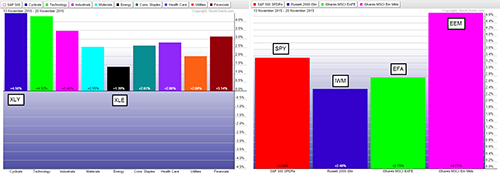
But as the U.S. indexes continue to climb back, their breadth remains narrow as a few large and mega caps provide most of the gains. How long will this continue?
The hedge fund industry is hoping that positive returns will broaden as they need to catch up after a disastrous few months…
Hedge funds fared poorly during the market correction in August, and have yet to recover (page 4). Since our VIP basket was last rebalanced in August, the list of hedge fund favorites has trailed the S&P 500 by 6 pp (-5% vs. +1%). Health Care stocks within the basket, most notably VRX, were responsible for nearly 70% of the basket’s negative return. The average hedge fund has returned -2% YTD, underperforming both the S&P 500 (+3%) and the 10-Year Treasury (+1%).
(Goldman Sachs (N:GS))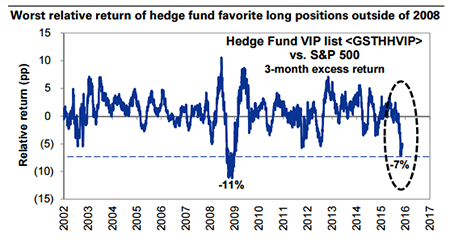
One sector that has been crushed this month has been brick and mortar retail. Not only is Amazon (O:AMZN) taking significant market share, but large secular changes are taking place. Here is the CEO of Abercrombie & Fitch explaining what you already know if you have teenagers or millennial kids…
“What clearly has happened is that apparel is a smaller share of wallets… A greater share of their money is going to, I’d say, two things. Number one is technology: iPhones, iPads, iWatch, whatever it might be,” Martinez said. “And the other thing is — I’d call it experiences: dining out with friends.”
The data (in red) clearly shows which categories are seeing significant pressures at the department stores or specialty retailers…
Spending pressures can also be seen in the lengthening maturity of auto loans. This seems to be quite risky given the rapidly evolving auto technologies (electric) and the shift to a sharing model (uber).
Maybe even worse is that sub-prime auto lending is firing up…
While retailers see a slowdown in spending, the bonds of retailers are also seeing less demand…

Also limiting Retailer profits is the increase in worker wages. Of course wage inflation has other implications for the Fed…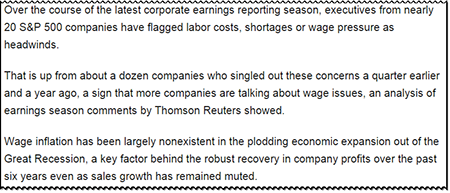
Last week, Health Insurance companies got a refresher course in adverse selection. No surprise that when the price of a widget rises 40%, one buys less. Or if you are a healthy 20 year old, you gamble and don’t buy any at all…
“In recent weeks, growth expectations for individual exchange participation have tempered industrywide, co-operatives have failed, and market data has signaled higher risks and more difficulties while our own claims experience has deteriorated, so we are taking this proactive step.”
(United Healthcare cuts its 2015 guidance)
Your Fed quote of the week comes from Mr. Fischer with a hat tip to Nike…
“In the relatively near future probably some major central banks will begin gradually moving away from near-zero interest rates. The question here is whether the emerging market countries of Asia–and, indeed, of the world–are sufficiently prepared for these decisions, to the extent that potential capital flows and market adjustments can take place without major macroeconomic consequences. While we continue to scrutinize incoming data, and no final decisions have been made, we have done everything we can to avoid surprising the markets and governments when we move, to the extent that several emerging market (and other) central bankers have, for some time, been telling the Fed to “just do it”".
Lindsey Piegza, the chief economist at Stifel, thinks the Federal Reserve has backed itself into a corner…
We discussed post-Paris impacts last week. Here is a specific data point on the tourism impact for the most traveled city in the world…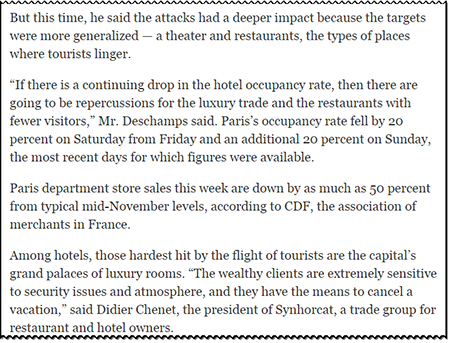
Back to slowing world growth rates and its impact on commodity prices…
(Eric Peters/One River Asset Management)
Don’t hold your breath waiting for a recovery in base metal prices…
Caterpillar (N:CAT) likes to hear that their customers won’t be cutting production, but if prices fall below extraction price, how long might those customers remain solvent to pay for their equipment…
If you’re looking for a chart that illustrates a long-term, worldwide industrial slowdown, look no further than Caterpillar’s monthly sales figures. The industrial giant’s sales have now declined for 35 straight months, with October’s 16% decline coming in as the largest drop during this streak and the biggest monthly decline since February 2010.
In October, the monthly slowdown was seen across regions and industries, with sales falling against the prior-year period in each of Caterpillar’s four global regions and three main industries. The most pronounced slowdowns were in construction sales in Latin America, where sales fell 41% in October, and in resources industry sales — basically mining and oil equipment — which fell 37% in Asia.
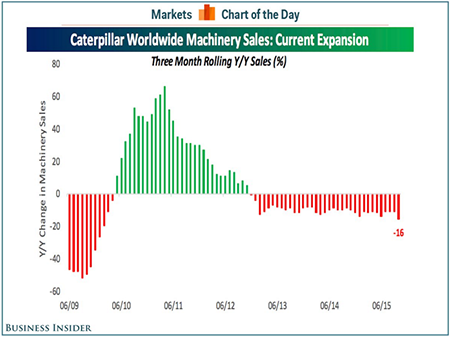
Goldman should create a market in leasing California swimming pools for crude oil storage…
Falling energy prices continue to weigh on energy stock prices while increasing the cost of energy credit default swaps…
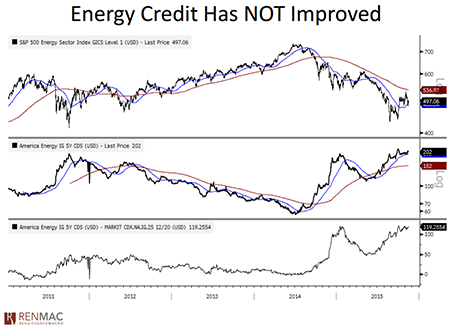
The largest name on every Energy bond and stock investor’s watch list last week was Chesapeake Energy. If this credit goes, it will run through many ETFs and portfolios…
Credit investors who lent $11 billion to Chesapeake Energy Corp (N:CHK). are starting to give up on the company, the second-biggest junk-debt issuer in the U.S. energy industry. Nearly all of the energy producer’s bonds plummeted to their lowest levels ever on Thursday as oil dropped toward a more-than six-year low. Chesapeake notes were the second-most actively traded in the high-yield market, just behind Petrobras Global Finance BV.
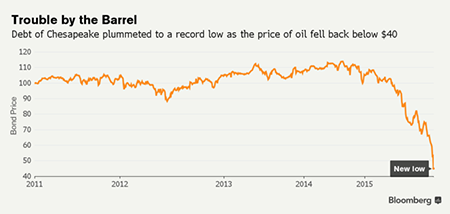
In November, Chesapeake Energy Corporation (N:CHK)’s stock price is -28% and back to prices seen from when my Oakland Raiders were running to their last Super Bowl…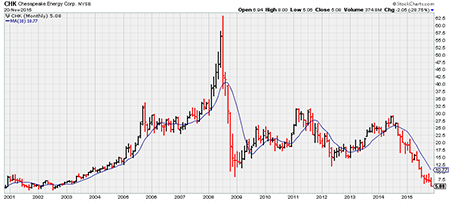
Speaking of debt-laden Energy companies, Petrobras ‘one upped’ Chesapeake by taking on significant amounts of US$ denominated debt…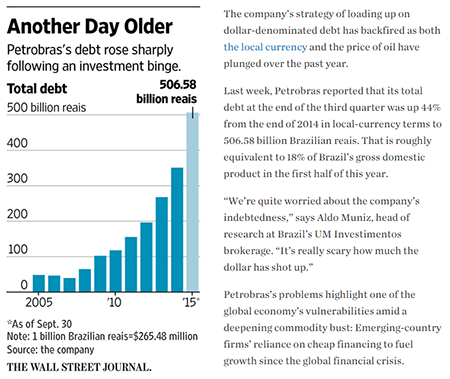
Jeff Gundlach of DoubleLine thinks that the number of credit downgrades will be a concern…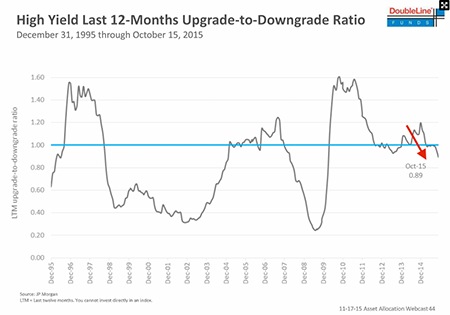
(BusinessInsider)
A further glimpse at the High Yield indexes show that we are back to levels not seen since European debt was blowing out…
Merrill Lynch high yield Master Index II effective yield (black line) and the yield on the CCC and lower segment (lowest rated credit/ red line). The worst rated bonds have been in relentless free-fall since the 2014 low in yields, with a move from 7.94% at the low to 14.71% today. Note bene, this has happened with administered interest rates stuck at zero over the entire time period! The better rated junk yielded 5.16% at the 2014 low, and yields 8% as of today, adding more that 280 basis points in bad juju since then. These yields are comparable to the woeful situation in 2011, when the euro area debt crisis was nearing its peak.
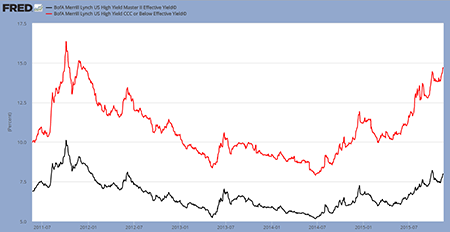
Deutsche Bank’s Jim Reid also wants you to pay attention to credit spreads…
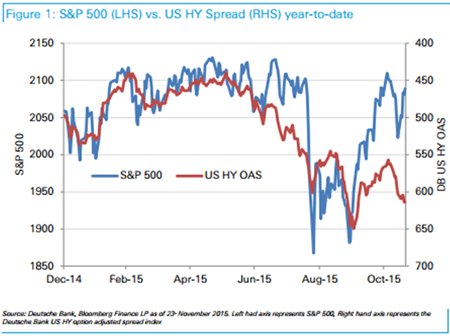
And it is not just High Yield bonds, but Bank loan spreads are also widening out. These are relatively more conservative instruments but also tightly correlated with equity and other risk prices…
(TheFelderReport)

CALPERS makes a move on its Pension Plan assumed investment rate. Wish them luck…
If you are an early investor, then ‘ratchet’ = ‘racket’ ???
Square Inc (N:SQ). will have to give some investors additional shares valued at $93 million after its initial public offering priced well below a promised threshold. The payments company’s IPO priced at $9, below an expected range of $11 to $13 and well under the $15.46 that investors including Rizvi Traverse and J.P. Morgan & Co. paid last fall. That $150 million funding round came with what’s called a “ratchet,” meaning the investors were guaranteed additional shares if the IPO price didn’t reach a certain level.
In this case, investors sought a 20% return on their investment, setting the IPO price in the ratchet at $18.56. Square missed that price by more than half, so it has to give the investors 10.3 million shares.
Square is among several companies, including Box Inc. and Kayak Software Corp., that accepted ratchets in private funding rounds. Law firm Fenwick & West LLP found in March that 30% of private companies valued at $1 billion or more had agreed to give investors some form of a ratchet. The IPO “ratchets” could become problematic in coming years if those companies can’t price their shares sufficiently high in public markets.
Who loves this chart? The Canadian tourism industry.
Who hates this chart? Any U.S. retailer within 5 miles of the Canadian border.
Something else that will aid Canadian tourism will be the hot and violent weather that will hit the U.S. in 2016 and 2017. Please make certain that your insurance coverages are maxed out if you have assets in a flood or fire zone…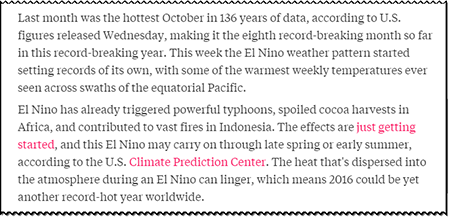
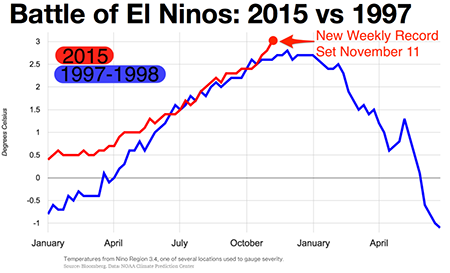
Here is a great long read from a former taxi driver on the rapidly shifting transportation industry…
And finally, your big thinking, long read of the week…
“The goal has not been: Let’s make cars,” Musk says. “The goal has been: We need to accelerate the advent of sustainable energy.”
DISCLAIMER: The information presented here is for informational purposes only, and this document is not to be construed as an offer to sell, or the solicitation of an offer to buy, securities. Some investments are not suitable for all investors, and there can be no assurance that any investment strategy will be successful. The hyperlinks included in this message provide direct access to other Internet resources, including Web sites. While we believe this information to be from reliable sources, 361 Capital is not responsible for the accuracy or content of information contained in these sites. Although we make every effort to ensure these links are accurate, up to date and relevant, we cannot take responsibility for pages maintained by external providers. The views expressed by these external providers on their own Web pages or on external sites they link to are not necessarily those of 361 Capital.

